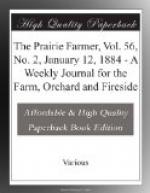A similar treatment may be adopted when a hedge becomes too high by long years of growth. The trees are first partly trimmed with a light axe or hook with a long handle, and then half cut off at the ground and bent over. A new growth will spring up and form a new hedge. This course was adopted by the essayist with a hedge planted twenty-eight years ago, and which has been a perfect farm barrier for more than twenty years. The cost of this hedge was about twenty-five cents a rod the first year, and the three subsequent cuttings for sixty rods cost about twenty dollars, averaging less than a dollar a year. But it was usually too tall and shaded, and occupied too much ground, to be recommended where land is valuable.
Ninety rods of Osage orange hedge, properly trimmed, cost about the same for the first four years of cultivation, but more for annual cutting back. It was planted twenty-four years ago, and has been a perfect barrier for about twenty years. The yearly cost of pruning was about four cents a rod for ten or twelve years, and since it has become larger and higher nearly double. For cutting back a stout hook with a handle two and a-half feet long or a stout scythe was used. Hedge shears are too slow except for ornamental hedges, and even for these the knife is preferable.
The Honey locust has been extensively used for hedges of late years on account of its hardiness. Seed should be selected from the most thorny trees. The trees have a tall, slender, and not hedgy growth, and require thorough cutting back to secure a thick mass of branches at the bottom, and very few have received this treatment when young. The care in planting and rearing is similar to that required by the Osage orange.
Many hedges have been injured or even destroyed by pruning after the summer growth has commenced. The pruning must be done in spring before the buds swell, if vigorous growth is to be preserved. But strong-growing hedges, that are likely to become too high, may be checked by summer pruning.
Though the cost of planting and starting a hedge is less than that of building a good board fence, they are not adapted to farmers who will not give them the continued care required to keep them in good order. This conclusion is justified by observing how few have succeeded with hedges, and many have allowed them to be ruined by neglect.
The evergreens which have been employed have been exclusively for ornamental screens, and not for farm barriers. The Norway spruce may be placed at the head on account of its rigid growth, hardiness, and the freedom with which it may be cut back, it will bear more shade than many other evergreens, and hence the interior of the screen is green with foliage. The cutting back should be done with a knife, and not with shears. Next to the Norway spruce is the hemlock, which excels the former in its livelier green in winter, while it is unsurpassed for retaining interior foliage. It will bear cutting back to an almost unlimited extent in spring before growth commences. But it is not so stiff as the Norway spruce as a barrier. The American arbor-vitae, though much used, becomes destitute of foliage inside, and is browned by winter.




